Neuromodulation Market Research, 2030
The global neuromodulation market size was valued at $2,480.21 million in 2020, and is projected to reach $4,342.50 million by 2030, growing at a CAGR of 6.2% from 2021 to 2030.
Neurological disorders is defined as disorders that affect the brain as well as the nerves found throughout the human body and the spinal cord. The acute spinal cord injury, Alzheimer’s disease, amyotrophic lateral sclerosis (ALS), ataxia, bell's palsy, brain tumors, cerebral aneurysm, epilepsy, and seizures are some of the common neurological disorders. The biochemical, structural, or electrical abnormalities in the brain, spinal cord, or other nerves result in wide range of symptoms, such as memory loss, impaired mental ability, lack of coordination, and persistent or sudden onset of a headache. The neuromodulation technology utilizes devices that bring about a change in nervous system either by stimulation or by modulating brain activity. These are used when the traditional treatments have failed to evoke desired response.
The growth of the global neuromodulation market size is majorly driven by the increase in prevalence of different types of neurological disorders, such as Alzheimer’s disease, dementia stroke, and brain tumor. For instance, according to Centers for Disease Control and Prevention (CDC), stroke is a leading cause of death in the U.S., killing 150,000 Americans in 2019. Moreover, advantages of neuromodulation device therapies over traditional drug treatment are expected to fuel their adoption in the analysis period.
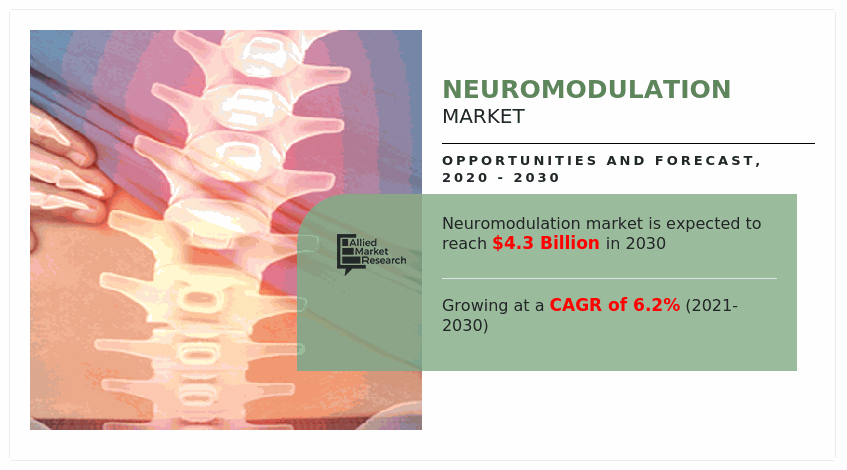
The growth of the neuromodulation market share is attributed to the increase in prevalence of brain disorders and increase in adoption of neuromodulation devices in developed countries. The deep brain stimulation (DBS) system are used in the treatment of epilepsy and Parkinson’s diseases. The rise in prevalence of epilepsy boosts the neuromodulation market growth. For instance, according to World Health Organization (WHO), in February 2022, epilepsy is a chronic non-communicable disease of the brain that affects population of all ages. As per the same source, it was also reported that around 50 million population were diagnosed with epilepsy, across the globe. In addition, increase in geriatric population further contributed in the growth of the market. The old age people are prone for neurological diseases, such as Alzheimer’s. For instance, as per the Alzheimer’s association, a non-profit organization, in 2021, it was estimated that around 6.2 million Americans aged 65 and older are diagnosed with Alzheimer's dementia.
Furthermore, leading players have increased their R&D activities on neurostimulation devices, and surge the growth of the neuromodulation industry. A large number of innovative technologies are in clinical trials currently. Major players are also in the process of collaboration, for development of innovative neuromodulation technologies. For instance, in February 2020, LivaNova PLC, a market-leading medical technology and innovation company, entered in collaboration with Verily to gain new insights into Vagus Nerve Stimulation impact on difficult-to-treat depression. In addition, increase in key players and new product launch in developing countries drives the growth of the market. Moreover, in July 2021, Medtronic, a global manufacturer of medical devices announced the launch of ‘Percept PC’, which is the first deep brain stimulation (DBS) system with BrainSense technology for movement disorders such as Parkinson’s and epilepsy in India.
Moreover, advancement in neuromodulation devices and new product approval by food and drug administration (FDA) are anticipated to contribute toward the growth of the neuromodulation market trends. For instance, in January 2021, Boston Scientific Corporation, a leading provider of medical devices announced the FDA approval for the ‘Vercise Genus’, which is a deep brain stimulation system consists of a bluetooth-enabled, rechargeable, and non-rechargeable, implantable pulse generators (IPGs). However, high cost of devices and lack of awareness about neuromodulation devices impede the growth of the market.
Global Neuromodulation market segmentation
The neuromodulation market size is segmented on the basis of technology, application, biomaterial and region.
By Technology
By technology, the market is mainly categorized into internal neuromodulation and external neuromodulation. The internal neuromodulation is further classified into deep brain stimulation, sacral nerve stimulation, vagus nerve stimulation, spinal cord stimulation, and other neuromodulation technologies. On the basis of external neuromodulation, it is further divided into transcutaneous electrical nerve stimulation and transcranial magnetic stimulation.
By Application
By application, it is categorized in chronic pain, urinary and fecal incontinence, migraine, failed back syndrome, Parkinson disease, epilepsy, tremor, depression, and other applications.
By Biomaterial
On the basis of biomaterial, it is divided into, metallic biomaterials, polymeric biomaterials and ceramic biomaterials.
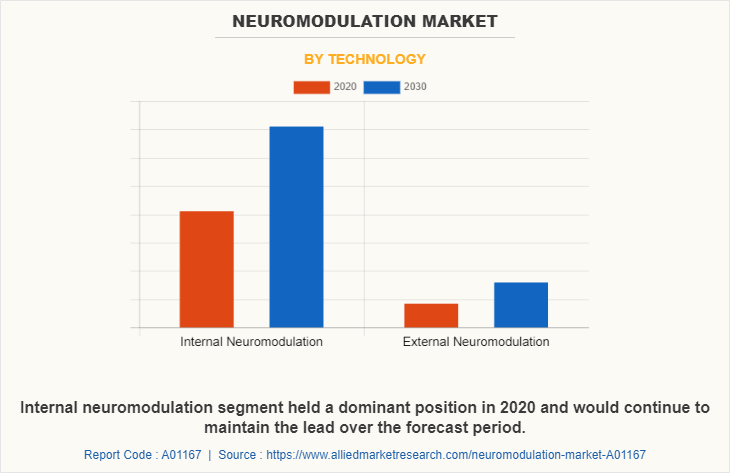
By Region
By region, the market is analyzed across North America (U.S., Canada, and Mexico), Europe (Germany, France, the UK, Italy, Spain, and Rest of Europe), Asia-Pacific (Japan, China, India, South Korea, Malaysia and Rest of Asia-Pacific), and LAMEA (Brazil, Israel, South Africa, Saudi Arabia and Rest of LAMEA).
Segment Review
Depending on technology, the internal neuromodulation segment dominated the market in 2020, and this trend is expected to continue during the forecast period, owing to rise in prevalence of Parkinson’s disease and increase in product approval for neurological disease treatment. However, the external neuromodulation segment is expected to witness considerable growth during the forecast period, due to advancement in technology for external neuromodulation devices.
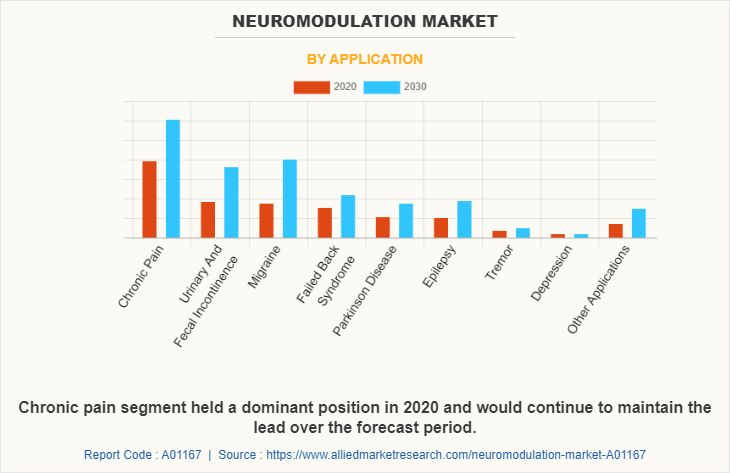
On the basis of application, the chronic pain segment dominated the market in 2020, and this trend is expected to continue during the forecast period, owing to rise in prevalence of chronic disease and increase in R&D activities in healthcare sector. However, the migraine segment is expected to witness considerable growth during the forecast period, due to increase in prevalence of migraine and rise in sedentary lifestyle.
Depending on biomaterial, the metallic biomaterials segment was the major contributor in 2020 and is expected to maintain its lead during the forecast period, owing to advancements in metallic biomaterials. However, the polymeric biomaterials segment is expected to witness considerable growth during the forecast period, due to increase in prevalence of Parkinson’s disease.
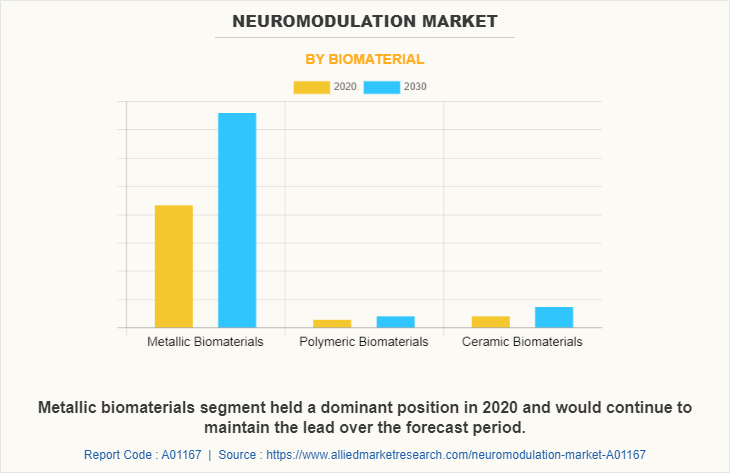
Depending on the region, North America garnered the major share in the neuromodulation market in 2020, and is expected to dominate the global market during the forecast period, owing to the rise in prevalence of neurological diseases, presence of key players for development of neuromodulation devices, and well-established infrastructure in the region. However, Asia-Pacific is expected to register the highest CAGR of 7.5% from 2021 to 2030, owing to an increase in the number of hospitals, prevalence of epilepsy and high geriatric population.
The key players operating in the global neuromodulation market include, Abbott, Aleva, Neurotherapeutics SA., Boston Scientific Corporation, LivaNova, Medtronic, MicroTransponder, Neuronetics, NeuroPace Inc., NeuroSigma, and Nevro Corporation.
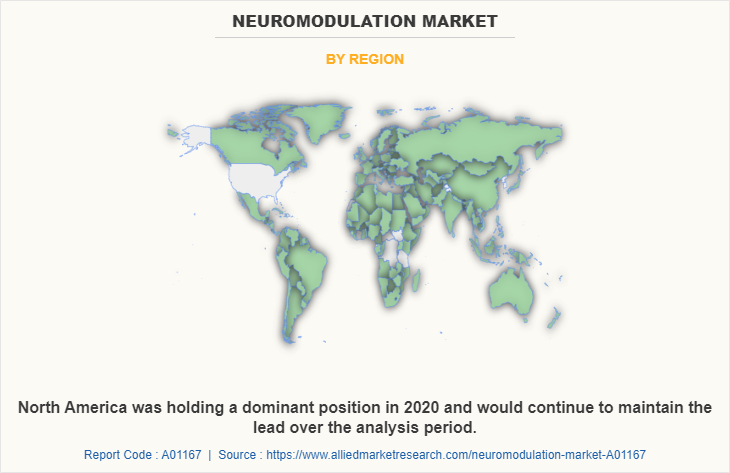
Key Benefits For Stakeholders
- This report provides a quantitative analysis of the market segments, current trends, estimations, and dynamics of the neuromodulation market analysis from 2020 to 2030 to identify the prevailing neuromodulation market opportunities.
- The market research is offered along with information related to key drivers, restraints, and opportunities.
- Porter's five forces analysis highlights the potency of buyers and suppliers to enable stakeholders make profit-oriented business decisions and strengthen their supplier-buyer network.
- In-depth analysis of the neuromodulation market segmentation assists to determine the prevailing market opportunities.
- Major countries in each region are mapped according to their revenue contribution to the global market.
- Market player positioning facilitates benchmarking and provides a clear understanding of the present position of the market players.
- The report includes the analysis of the regional as well as global neuromodulation market trends, key players, market segments, application areas, and market growth strategies.
Neuromodulation Market Report Highlights
| Aspects | Details |
| By Technology |
|
| By Application |
|
| By Biomaterial |
|
| By Region |
|
| Key Market Players | Boston Scientific Corporation, MicroTransponder, Bioventus Inc., Nevro Corporation, Neuronetics, NeuroSigma, LivaNova PLC, Medtronic, MicroTransponder, NeuroPace Inc, Abbott |
Analyst Review
Neuromodulation devices are mainly used for the treatment of neurological disorders, such as epilepsy, Alzheimers, and Parkinson’s disease.
The internal neuromodulation dominates the market owing to the increase in R&D activity in deep brain stimulation (DBS) and vagus nerve stimulation (VNS).
Factors such as increase in prevalence of neurological diseases, rise in number of hospitals, and rise in geriatric population drive the growth of market. In addition, advancements in neuromodulation devices are expected to drive the growth of the neuromodulation market.
North America is expected to witness the highest growth, in terms of revenue, owing to the rise in prevalence of epilepsy, the presence of key players, increase in R&D activities in neuromodulation devices, and increase in number of hospitals and diagnostic centers, in the region.
However, the high cost of treatments and lack of awareness for use of neuromodulation devices are expected to hamper market growth during the forecast period.
The total market value of neuromodulation market is $2,480.2 million in 2020.
The market value of neuromodulation market in 2021 was $2,532.3 million
The base year for the report is 2020.
Yes, neuromodulation companies are profiled in the report
The top companies that hold the market share in neuromodulation market are Boston Scientific Corporation, Abbott, LivaNova, Nevro Corporation, Medtronic, NeuroSigma, Neuronetics, Bioventus Inc., NeuroPace Inc and MicroTransponder.
Asia-Pacific is expected to register the highest CAGR of 7.5% from 2021 to 2030, owing to increase in prevalence of neurological diseases, and advancement in neuromodulation devices.
The key trends in the neuromodulation market are by an increase in the prevalence of epilepsy; rise in number of hospitals; and R&D in neuromodulation devices.
Loading Table Of Content...



